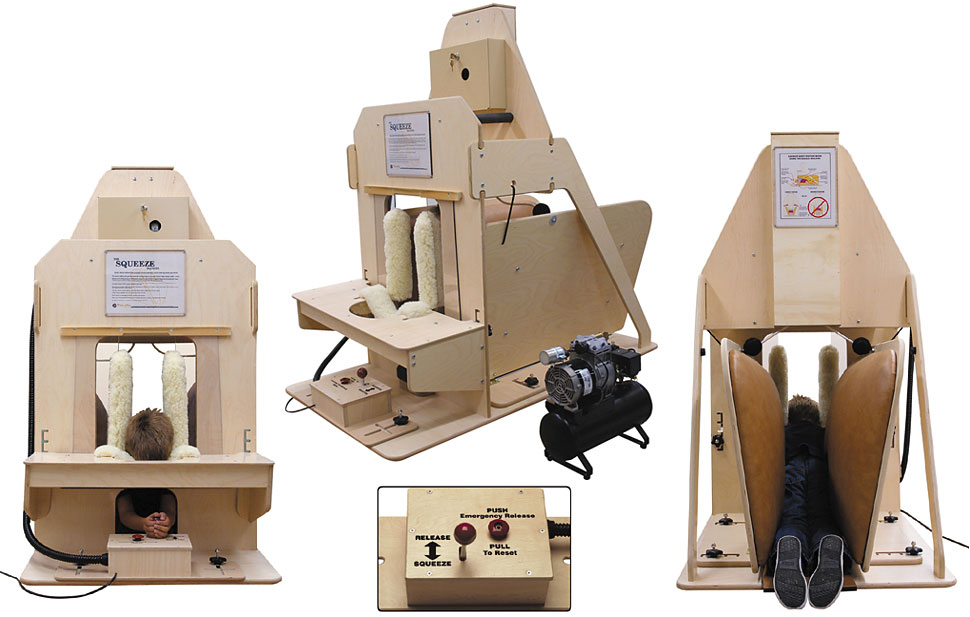
We talk a lot about designing and utilizing furniture to support natural human behavior. It’s what we believe should be the foundation for furniture use in public spaces.
A lot of times it’s easy to simply look at furniture through the lens of its intended purpose. What will it be used for? (Which totally makes sense!)
But what if we started to expand our perspective of furniture to look through the lens of how the furniture will make our patrons feel?
Will it make them feel secure? Or will it make them feel exposed? Will it make them feel productive? Or will it make them feel distracted? Will it make them feel calm? Or will it make them feel stressed? And the list goes on.
Sure, it might seem like an odd question to be asking. But today as we continue our conversation on biophilia, we’re going to look at some research that makes it a viable question worth considering as we design our spaces:
Temple Grandin’s Squeeze Machine
You may have heard of Temple Grandin, a renowned American scientist and professor of animal science. Diagnosed with autism at the age of 3, doctors originally recommended that she be institutionalized. After her parents rejected this suggestion, Grandin went on to earn a PhD from The University of Illinois in animal science and become a highly influential autism-rights activist.
When Grandin was a child, she often became overwhelmed by external stimuli. In her own words, “I had standard autistic symptoms such as intolerance to being touched, inability to speak, tantrums, and stereotypic behavior. I would stiffen and pull away when people touched me, and I was oversensitive to both touch and sound…”
As she got older, Grandin made an observation in animal science. As cattle would be waiting for veterinary attention, they would often display clear signs of agitation and nervousness, but would appear to calm down once pressure was applied to large areas of their bodies.
At the age of 18, her observations led her to develop the squeeze machine in order to calm her own anxiety. Because the machine applied consistent pressure across a large portion of her body, it produced a relaxing effect, in contrast with the overwhelming sensation she experienced from a typical hug. She recalls, “Using the machine for 15 minutes would reduce my anxiety for up to 45-60 minutes. The relaxing effect was maximized if the machine was used twice a day.”

Source: Therafin Corporation
Grandin’s invention and subsequent research has been a foundation for the research into the positive effects of touch.
It’s Not Just a Story; It’s Science
Even by simply looking at our own lives, most of us would likely agree that touch from the right person can drastically improve our day. In recent years, the topic of touch has received greater attention from researchers. Here’s a rapid-fire overview:
The simple act of hugging increases levels of oxytocin in the brain, which lowers the physical effects of stress, including blood pressure, heart rate, and cortisol levels.
A study published in Psychological Science discovered that touch, even from an inanimate object, increased hope for the future. This research “suggests that simulated interpersonal touch may already have significant existential benefits, [particularly] for individuals with low self esteem.”
Beyond that, research into touch therapy discovered that touch/massage therapy has the potential to decrease cortisol (stress hormone), increase serotonin and dopamine (mood neurotransmitters), and stimulate the vagus nerve, which runs to the heart and other organs.
Grandin’s own research with her squeeze machine uncovered that, in addition to the benefits for those with autism, more than half of college students felt relaxed after using the squeeze machine.
So what’s the point? The reality is that touch matters. As we are utilizing furniture to create spaces that make people feel comfortable, confident, and productive, we need to expand our perspective of furniture away from simply what it will be used for and towards how it will make our patrons feel.
Pairing Touch With Refuge: Creating Calm
Highlighting this research is part of a greater conversation on understanding a study called biophilia. As we recently shared, biophilia, in relation to design, is the study of how to connect our patrons with nature and elicit a positive response to the space by leveraging innate human behavior. If we don’t address the innate needs our patrons have, we leave them feeling insecure or exposed rather than protected and comfortable.
One of the key aspects of using furniture to create a biophilic response is Refuge, which is accomplished by providing haven from the main flow of a space, often consisting of a covering for an individual’s back.
In a recent study on urban design, researchers discovered, “People do not feel comfortable walking through the middle of spaces… This is an expression of subconscious feelings of being protected from danger; one wants to be next to something solid, facing outwards.”
These subconscious feelings are what we want to address in our spaces. By providing furniture that goes beyond privacy and instead provides security, we create a feeling within our patrons of safety, calm, comfort, and confidence, pushing back against the feelings of stress many of them come into our spaces with.

